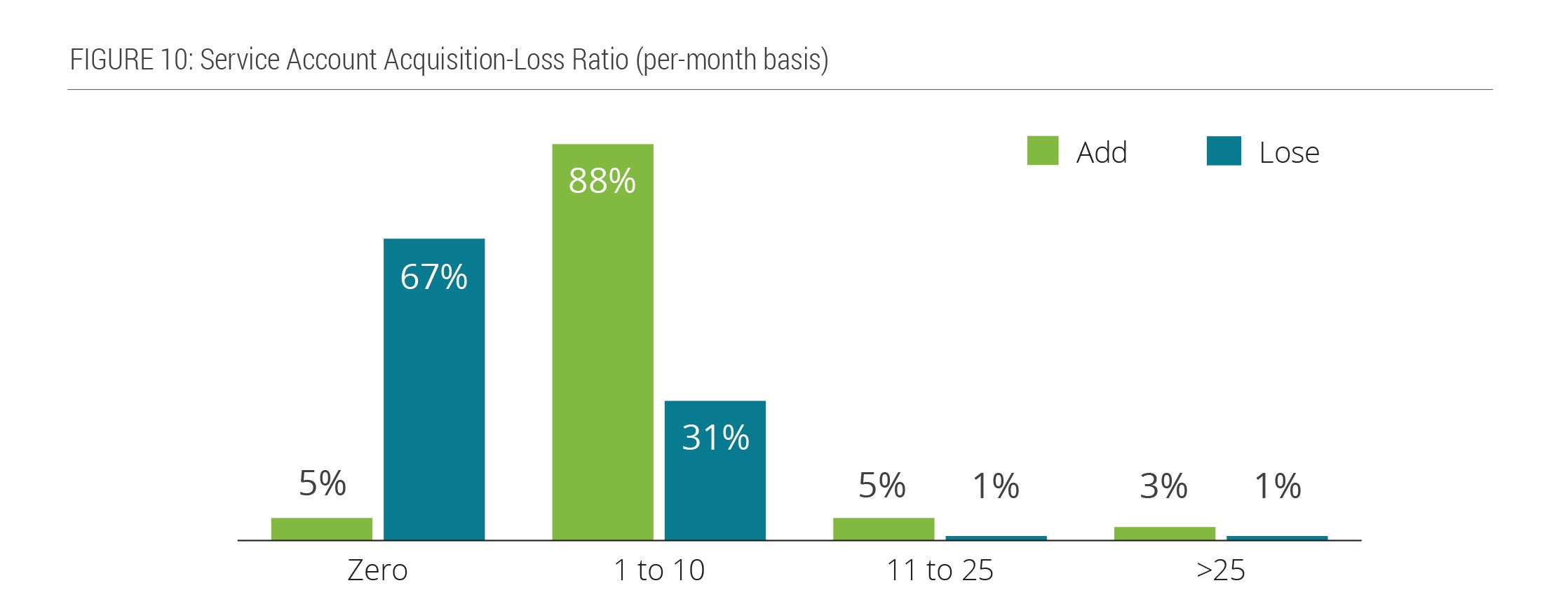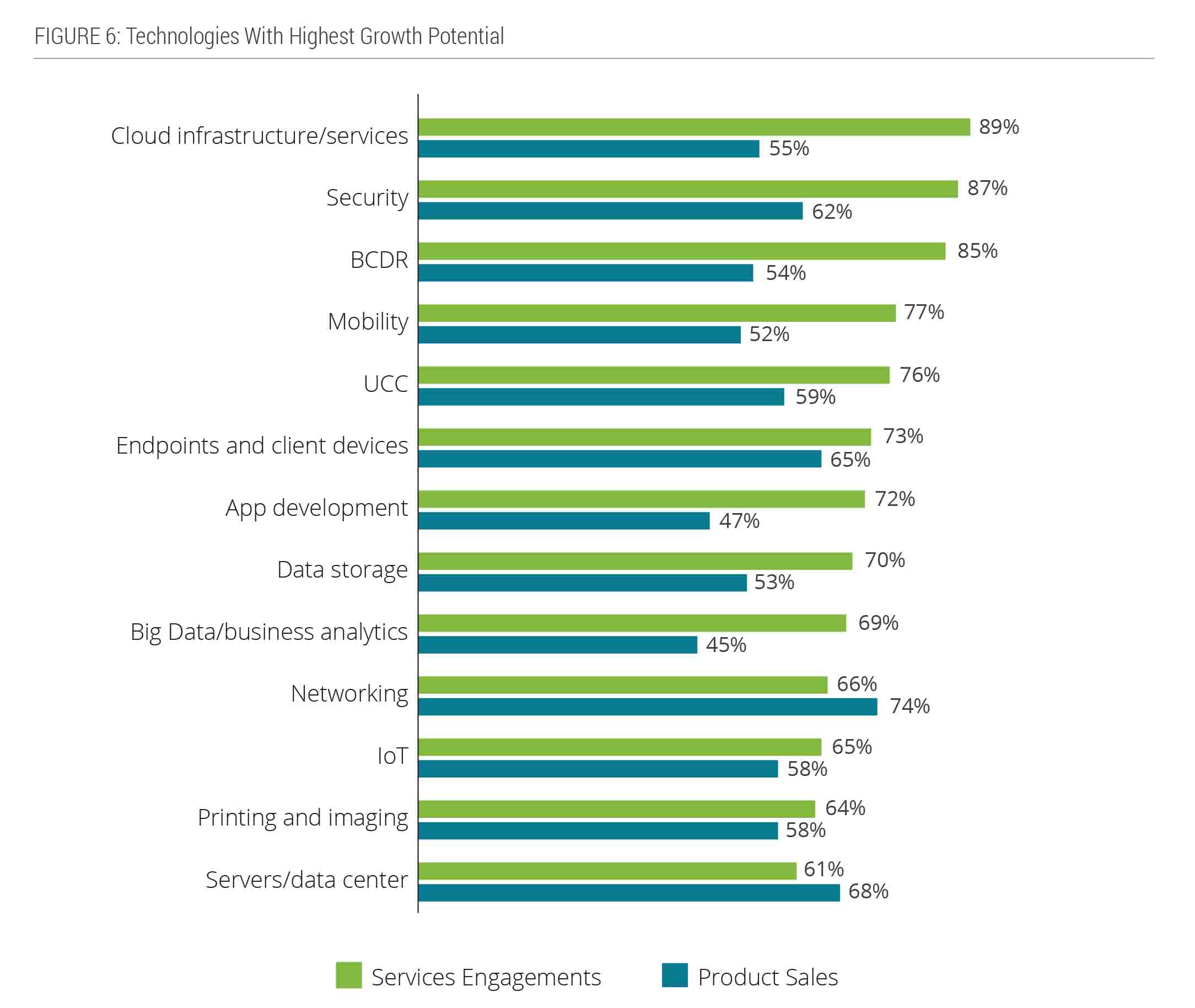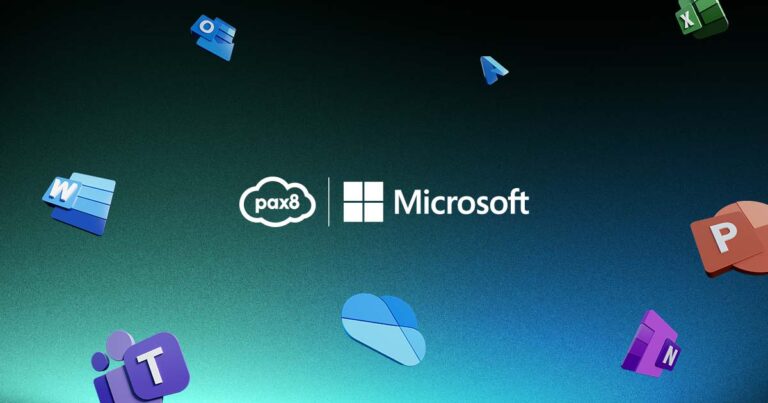How to get unstuck when growing your MSP business.
Every industry publication points to incredible growth potential for the managed services industry in the coming years, and with nearly every business requiring technology, growth projections make sense. On the ground, however, it’s a different story. Many managed services providers (MSPs) struggle to sustainably grow their business.
As an MSP, you are often faced with intense competition not just from other IT providers, but also from vendors and resellers who can often offer more competitive pricing. With customers not fully understanding the full value of managed services and how they can benefit from your services, selling becomes a race to the lowest price point. Furthermore, the cost of hiring additional technicians or staff members necessary for scaling up a business adds financial strain — particularly in the ongoing labor market. These are just two issues that start to explain why two-thirds of MSPs struggle to maintain profitability.
The MSP market is anticipated to continue to grow in the coming years, particularly with regards to servicing the small- to medium-sized business (SMB) market. Not only that, but the volume of service offerings that IT providers offer will continue to evolve and grow. In fact, 72% of solution providers plan to increase their service offerings in the next 12 months.
With a growing and ready-made market and a service offering that is instrumental to organizational success, why are so many MSPs struggling with growth? We dig into five key problems that are holding IT service providers back from growth.
1. Short-Sighted Business Planning
A proper business plan is key when launching a successful business. It serves as a roadmap, providing an outline of what the business goals are and how those goals will be met. It can also help identify strengths and weaknesses, anticipate changes in the market or consumer demand, set realistic expectations for growth, and document critical processes and policies from operations to marketing plans.
And yet, only 60% of solution providers have a general business plan that defines and governs their business operations. That lack of planning contributes to other operational pressures. More than one-quarter of those solution providers say they’re challenged by the lack of time and resources to do their jobs effectively. Others face difficulty keeping current with new technologies and emerging skills, retaining customers, and staving off competition.
Sales and Marketing Are Taking a Backseat
The research shows that the lack of planning doesn’t hinder the current revenue and profitability performance of solution providers, as market momentum carries them forward. However, the lack of sales and marketing planning does contribute to general uneasiness among solution providers, which saps their confidence and challenges their ability to forecast future growth accurately.
Consider these statistics that illustrate a very real gap in sales and marketing activities among providers:
- Only 33% of solution providers have a sales plan
- Only 12% have sales goals for their cloud services
- 55% don’t have established sales goals
- 48% of solution providers don’t have a general marketing plan
- Only 14% have plans for marketing their cloud offerings and capabilities
Sales and marketing challenges are long-standing issues among solution providers. Perennial studies often find MSPs concede that their lack of marketing and sales capabilities stymie their revenue creation and stability. This chronic sales challenge is why 60% of solution providers are adopting more services to build and sustain recurring revenue. With more recurring revenue from accounts under contract, MSPs are under less pressure to generate net-new sales.
For a cohort that’s focused on growing services, solution providers aren’t planning for success.
2. Poor Business Development
Most solution providers say they’re building services to develop and sustain recurring revenue. When flowing smoothly, the recurring revenue paradigm can deliver predictable income and profits. With more predictable revenue, solution providers will mitigate the pressure they feel from their sales and marketing challenges.
Account Acquisition vs. Account Retention
Two things make the recurring-revenue model work: account acquisition and account retention.
Revenue compounds as more customers are brought under contract and expand their service consumption. What makes recurring revenue predictable, though, is account retention.
Customer renewal means that every new account is compounding new revenue on top of the existing base. If account retention is low – or, conversely, account attrition is high – the recurring-revenue model is unstable because the revenue stream isn’t predictable.
- 88% of IT providers report adding 1 to 10 new accounts per month
- 31% report losing the same amount
- 67% of solution providers report losing no customers each month
- For all the partners in the study, these numbers add up to a 2.5-to-1 ratio of new accounts to lost accounts each month

Can Your Organization Afford the High Cost of Turnover?
Customer turnover is costly. Experts put the cost of acquiring a new customer at 5–25 times higher than keeping an existing client. That long-term trust you cultivate with your clients cannot be overvalued.
3. A Slapdash Solution Stack
Your solution stack is a critical component of your service delivery. The right mix of tools and services enables you to optimize service delivery, provide the highest level of client satisfaction and, ultimately, scale your business.
Some MSPs focus on technical specifications and the most modern tools to impress their customers. The result is often that they carry a wider variety of solution options, increasing the demands on the business to support these solutions, often to varying degrees of success.
A more efficient model is to focus on combining and standardizing applications, systems, and tools that foster collaboration between teams and maximize efficiency.
The 6 Cs of a Strategic Solution Stack
Thinking of your solution stack holistically ensures that every component is valuable to the client and aligned to your business strategy. Strategic solution stacks share these six characteristics:
- Comprehensive – your stack should cover all the bases for your customers’ foundational IT needs while also providing room for growth and maturation.
- Complementary – each solution added to the solution stack must be compatible with the other solutions included in the portfolio.
- Consolidated – the ability to order, provision, and bill your full stack in a single commerce marketplace will streamline your operations and save considerable time and money.
- Curated – every product you offer must be carefully vetted to ensure it integrates seamlessly and adds value to your overall stack.
- Competitive – always try your best to balance best-in-class capabilities with budget realities.
- Commitment – onboard all clients to your solution stack as soon as possible, even when ripping and replacing recently deployed alternatives.
The first step is to align your stack to these six Cs. As you do, standardize your stacks as much as possible. This will lead to a more consistent service quality, streamline client onboarding and offboarding, and result in significant operational and financial efficiencies.
4. Inferior Business Processes
A lack of defined business processes not only affects your ability to deliver quality service, but also hampers your growth. Without well-formed workflows, support requests can easily slip through the cracks and remain unaddressed for days or weeks. Over time, this leads to disgruntled customers and diminished profitability due to inefficiencies in service delivery. Furthermore, when processes are nonexistent or underspecified, they create chaos in an organization and your employees can’t carry out their tasks quickly and smoothly. This can contribute to employee dissatisfaction and churn.
The Future of Cloud Management
As you grow, give equal attention to both resource utilization and process optimization. Many MSPs focus only on utilization, but your costs will always increase as you add personnel to provide even basic levels of service. By having well-defined processes early on, your team operates much more efficiently, with higher rates of customer satisfaction, meaning more profit margins and long-term success for your business. And, of course, it’s imperative to re-evaluate those processes as you grow to ensure your potential for scalability. The Pax8 Marketplace is supporting MSPs all over the globe achieve this with a suite of processes that help you:
- Save time
- Reduce human error
- Increase proactive support capabilities
- Gain multitenant visibility
- Optimize client security
- Acquire new business
- Simplify cloud management
- Create hard data for long-term success
5. Ignoring the Data
The fifth problem holding many companies back is failing to leverage the vast amounts of data they have access to.
Data provides MSPs with valuable insights into the behavior of their customers. With this knowledge in hand, you can proactively identify opportunities to provide better services and drive business development.
Gain a Competitive Advantage by Leveraging Data
From improving customer service levels to optimizing operations, data-driven decisions have a huge impact on the performance of your business. Understanding the needs of each customer allows for more targeted marketing strategies, reaching new clients and strengthening existing relationships. Data not only provides an understanding of trends and behaviors, but it also supports continuous improvement initiatives by showing you what works and what needs improvement.
Accelerate Your Growth
The data is in: solutions providers are bullish on services – mainly services that support traditional products (see graph below). More than 80% of solution providers see growth opportunities in cloud infrastructure, security services, and cloud-based backup and disaster recovery – just ask Pax8 partner LeafTech, which has achieved 230% growth since introducing cloud services. More than two-thirds of solution providers see potential in services around mobility, unified communications and collaboration, endpoint device management, storage services, and business analytics. The standout data point is that only two traditional product categories – networking equipment and data center servers – have higher growth potential for solution providers. The inverse means that services are overwhelmingly seen as more advantageous to solution providers in terms of growth and success going forward.

The growth potential is strong. However, growth is a mindset; it doesn’t happen without intention, attention, and dedication. It needs to be planned and funded. Pax8 Academy offers one such course tailor-made to help you break through your business plateaus.
With 9,000 partner organizations and counting, Pax8 Academy provides an entire team of MSP experts and coaches, with a collective 600 years’ worth of experience, to help propel your business forward. From on-demand learning opportunities to peer groups to business coaching, Pax8 will equip your organization with world-class expertise, top vendors, and real-time resources designed to help you grow.





